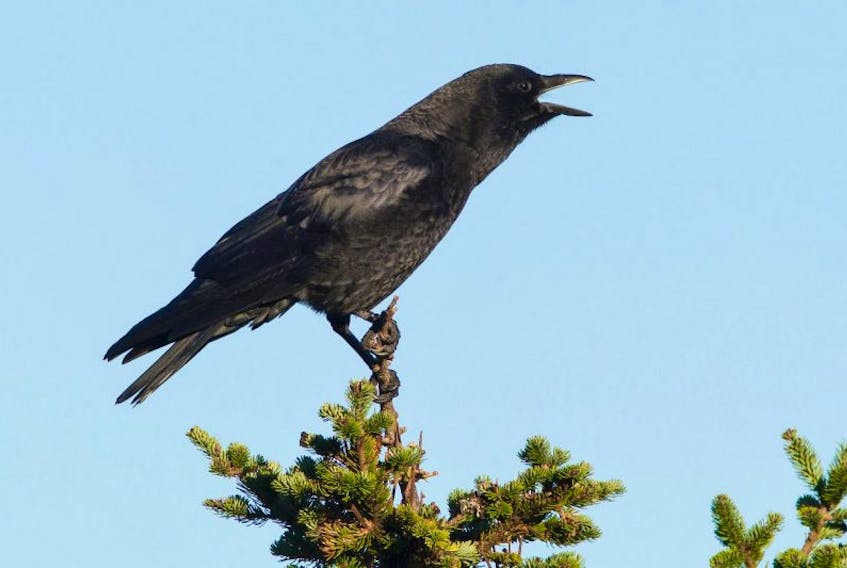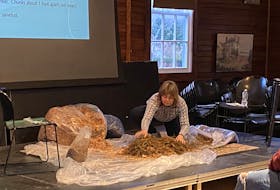There is a period of only a couple weeks per year when you will see that happen. It is in March when pairs of ravens are fixing up last year’s nest or building a new one. Their timing is based on the lengthening days of March and not the weather.
Later, I saw a pair of ravens flying back and forth to a nest site on the cliffs of Flatrock. I could see the outside rim of a stick nest but could not see what the ravens were doing in their little cave. This was a perfect location partially protected from the weather by a rock overhang. Nearby there was another stick nest that was not so sheltered from the rain but very firmly placed on a spacious rock shelf. There were no ravens attending this nest probably because it was too close to the pair in the cave.
Ravens do not nest close together.
The smaller cousin of the raven is the crow.
Crows are city dwellers. Crows get into nesting mode a week or so later than the ravens. During the last 10 days of March crows will be house cleaning last year’s nest or building a new one. The sight of a crow flying across the road carrying a stick is a promising sign of spring. Crows are going to have a field day building nests.
Urban backyards are littered with twigs and sticks of every size after last Saturday’s hurricane force wind ideal for nest building. There are more than enough sticks in my St. John’s backyard to build a crow’s nest from scratch.
On the other hand the thick spruce tree my local pair sometimes nested in on the property across the street blew over. It snapped of at mid-trunk and flopped across a driveway. Crows are crafty in their ability to have their nests in our midst without us knowing. I am sure these crows have already scouted out an alternate nest site.
How do you tell crow and ravens apart?
They are very different birds by nature and that helps distinguish them at times.
You are not likely to see a raven walking around the parking lot of a fast-food restaurant looking for fries. This is a specialty area for the crows.
Ravens generally fly over the city of St. John’s without stopping. The sighting of a raven often excites the crows as the raven is a potential threat and rival.
Ravens have not yet built up the courage to be near people but this may be slowly changing. Crows are smaller and lighter on the wing with a shorter more rounded tail.
Usually you cannot see a raven close enough to notice its much heavier bill and shaggy throat feathers.
Even the most experienced bird watchers sometimes have to look twice to tell the difference between and a crow and a raven.
Ravens, of course, call with a deep throaty croak and crows have their caw.
In Arctic cultures the raven has always been a respected bird. Never harassed and never considered a pest.
As a result the ravens in Arctic communities are tame as dogs. They are tamer than crows ever have been on the island of Newfoundland.
However, every year I see ravens pushing their barriers of fear a little farther with us urbanites. In recent years I have seen the occasional brave raven touch down into a fast-food parking lot to grab a fry or maybe check out an open dumpster behind a secluded building.
It will be interesting to see how far they will go in spreading their domain into our world of asphalt, steel and vinyl siding.
Storm News
The intense winter storm that this column was about last week did not produce much in the way of an avian fallout.
Perhaps related was the white gyrfalcon that Chris Brown and Ken Knowles saw making several passes by the kittiwake colony at Flatrock. Another gyrfalcon flew close over Jared Clarke and a lucky out-of-town visiting birdwatcher at Cape Spear.
These northern hawks were possibly driven south by the winds.
The incredible wind storm this past weekend that caused so much damage on the Avalon Peninsula did not have any obvious effect on birds. With the wind blowing offshore it is impossible to know what might have been blown out to sea.
Interestingly, there were goldfinches still feeding on the nyger seed sock at my birdfeeder during the height of the wind that Saturday afternoon.
The transition from winter to spring is often a little rough.
Spring is the light at the end of the tunnel.
Bruce Mactavish is an environmental consultant and avid birdwatcher. He can be reached at [email protected].
There is a period of only a couple weeks per year when you will see that happen. It is in March when pairs of ravens are fixing up last year’s nest or building a new one. Their timing is based on the lengthening days of March and not the weather.
Later, I saw a pair of ravens flying back and forth to a nest site on the cliffs of Flatrock. I could see the outside rim of a stick nest but could not see what the ravens were doing in their little cave. This was a perfect location partially protected from the weather by a rock overhang. Nearby there was another stick nest that was not so sheltered from the rain but very firmly placed on a spacious rock shelf. There were no ravens attending this nest probably because it was too close to the pair in the cave.
Ravens do not nest close together.
The smaller cousin of the raven is the crow.
Crows are city dwellers. Crows get into nesting mode a week or so later than the ravens. During the last 10 days of March crows will be house cleaning last year’s nest or building a new one. The sight of a crow flying across the road carrying a stick is a promising sign of spring. Crows are going to have a field day building nests.
Urban backyards are littered with twigs and sticks of every size after last Saturday’s hurricane force wind ideal for nest building. There are more than enough sticks in my St. John’s backyard to build a crow’s nest from scratch.
On the other hand the thick spruce tree my local pair sometimes nested in on the property across the street blew over. It snapped of at mid-trunk and flopped across a driveway. Crows are crafty in their ability to have their nests in our midst without us knowing. I am sure these crows have already scouted out an alternate nest site.
How do you tell crow and ravens apart?
They are very different birds by nature and that helps distinguish them at times.
You are not likely to see a raven walking around the parking lot of a fast-food restaurant looking for fries. This is a specialty area for the crows.
Ravens generally fly over the city of St. John’s without stopping. The sighting of a raven often excites the crows as the raven is a potential threat and rival.
Ravens have not yet built up the courage to be near people but this may be slowly changing. Crows are smaller and lighter on the wing with a shorter more rounded tail.
Usually you cannot see a raven close enough to notice its much heavier bill and shaggy throat feathers.
Even the most experienced bird watchers sometimes have to look twice to tell the difference between and a crow and a raven.
Ravens, of course, call with a deep throaty croak and crows have their caw.
In Arctic cultures the raven has always been a respected bird. Never harassed and never considered a pest.
As a result the ravens in Arctic communities are tame as dogs. They are tamer than crows ever have been on the island of Newfoundland.
However, every year I see ravens pushing their barriers of fear a little farther with us urbanites. In recent years I have seen the occasional brave raven touch down into a fast-food parking lot to grab a fry or maybe check out an open dumpster behind a secluded building.
It will be interesting to see how far they will go in spreading their domain into our world of asphalt, steel and vinyl siding.
Storm News
The intense winter storm that this column was about last week did not produce much in the way of an avian fallout.
Perhaps related was the white gyrfalcon that Chris Brown and Ken Knowles saw making several passes by the kittiwake colony at Flatrock. Another gyrfalcon flew close over Jared Clarke and a lucky out-of-town visiting birdwatcher at Cape Spear.
These northern hawks were possibly driven south by the winds.
The incredible wind storm this past weekend that caused so much damage on the Avalon Peninsula did not have any obvious effect on birds. With the wind blowing offshore it is impossible to know what might have been blown out to sea.
Interestingly, there were goldfinches still feeding on the nyger seed sock at my birdfeeder during the height of the wind that Saturday afternoon.
The transition from winter to spring is often a little rough.
Spring is the light at the end of the tunnel.
Bruce Mactavish is an environmental consultant and avid birdwatcher. He can be reached at [email protected].









